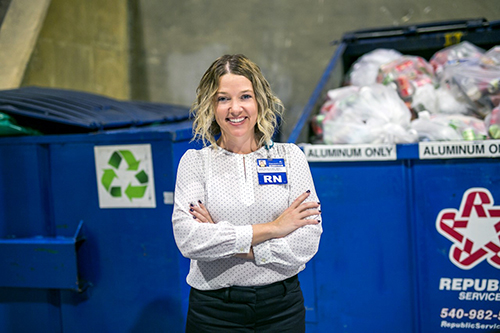
Ms. Wohlford is the director of sustainability for Carilion Clinic. The Roanoke, Va.-based health system has numerous awards and recognitions for its sustainability efforts that include everything from installing solar-power receptors to hiring sheep to keep the lawn. Carilion Clinic.
In a world transformed by environmental degradation and the effects of climate change, hospitals can be major generators of greenhouse gases, energy consumption, and waste. But they are also important centers for health and wellness promotion, not just for the patients they serve but also for staff and their communities. That is why a growing number of hospitals and their hospitalists are seeking ways to contribute to the conversation about sustainability and environmental stewardship for their facilities and the larger world.
Health involves more than health care, said Bill Flattery, CEO of Carilion New River Valley Medical Center in Christiansburg, Va. “We realize that health and well-being are affected by the environment in which we live, and we are stewards of that environment in the same way we are stewards of people’s health.”
This awareness has helped drive the 146-bed New River Valley Medical Center’s leadership in sustainability efforts. “It starts with understanding how much unbelievable waste there is in health care. If you acknowledge that fact, you can be invited into a culture that says we can do better,” Mr. Flattery said.
Hospitals can consider what they could do to run more efficiently, with reduced energy costs, enhanced patient experience, and public recognition for their efforts, he said. “We’ve done a lot at this hospital to demonstrate our green initiatives. This invites people to look at things with a different lens. And our hospitalist group has come up with some neat ideas to participate because of the culture we have established here.” For example, getting involved in conversations about how to reduce unnecessary waste of medical supplies.
A movement for sustainability
A sustainability movement is growing in U.S. hospitals, focused on ways to reduce waste and energy usage and promote healthier habits for the individual, the institution, and the world. Groups are leading the way, such as Practice Greenhealth, a membership, and networking organization for the health care community committed to environmentally sustainable practices; Sustainability Roadmap for Hospitals, an online initiative to help hospitals plan a path toward sustainability; and the global organization Health Care Without Harm.
“This is a direction that most, if not all, health care systems are now heading or soon will be,” says Sara Wohlford, MPH, RN, director of sustainability for the seven-hospital Carilion Clinic health system, based in Roanoke, Va. “Some health systems have decades-old sustainability programs. But the trend is growing by leaps and bounds. Meanwhile, we’re following conversations the Centers for Medicare and Medicaid Services, the Joint Commission, and other regulatory bodies are starting to have about sustainability. If new regulations come down, we’ll be ready,” she said.

Dr. Gundling
“Until four years ago, we had a lot of smart people who were working in silos on climate health and sustainability projects and didn’t know about each other,” said Katherine Gundling, MD, FACP, emerita professor of internal medicine and allergy/immunology—and a one-time hospitalist—at the University of California San Francisco (UCSF). “We were able to bring those people together.”
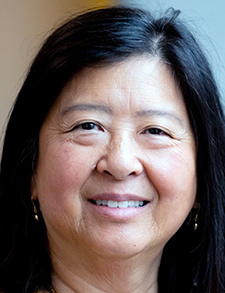
Ms. Lee
Now there’s a Center for Climate Health and Equity for all University of California campuses, for which Dr. Gundling is director of patient care innovations. UCSF’s Academic Senate Committee has endorsed two upcoming “theme years” dedicated to health and sustainability for the campus. “Now we are really moving forward,” she said.
UCSF has an Office of Sustainability, directed by Gail Lee, REHS, MS, HEM, who also supervises five health-professional graduate fellows in sustainability. The university is putting up a number of buildings in its new Mission Bay Campus, with a goal of powering them as much as possible with clean electricity rather than gas or other fossil fuels.
What are we talking about?
Sustainable design, which means trying to address how a facility’s practices affect the health and safety of its patients, staff, visitors, and the larger environment, can follow LEED (Leadership in Energy and Environmental Design) standards, introduced in 2000 by the U.S. Green Building Council. It may mean maximizing natural lighting and installing energy-efficient LED (light-emitting diode) light bulbs and motion-sensitive light dimmers.
Energy waste management may target, for example, the operating room and its waste. Are all the supplies set out for a medical procedure truly necessary, especially if they all must be discarded if not used—or even opened? Heating, ventilation, and air conditioning—also called HVAC—are major targets for energy-efficient practices, including scheduled preventive maintenance. Many hospitals have found that increasing energy efficiency makes significant contributions to their bottom line.
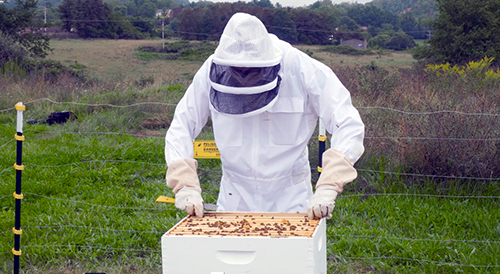
Carilion radiographer, Mr. Kolasa, tends to the apiary he installed in a field near the health center.
Regulating medical waste might aim to divert some that otherwise would end up incinerated or in landfills, focusing on improper waste labeling and re-educating staff about what needs to go into the red biohazardous waste bin. Questions are being asked about reusing, reprocessing, and recycling medical devices, such as reprocessing cardiac catheters and cleaning and recycling pulse oximeter cords.
How about bringing more local, fresh, and organic foods into the hospital’s dietary programs and onsite cafeterias? Some hospitals have hosted farmer’s markets on their campus or started in-house composting programs.
Sustainability also refers to the hospital’s human resources. Doctors and other clinicians face job stress and burnout. Could natural lighting or other environmental enhancements make them more comfortable in their jobs? What about the ergonomics of the workspace and the need for havens to relax and unwind while on the job? What else can make a hospital facility more tolerable to patients—and to all who use them or work there? Could the hospital offer yoga classes or educational programs for the staff or the public on environmental stewardship?
Ms. Wohlford, a former emergency department nurse who observed opportunities for enhancing sustainability on the job and got a master’s degree in public health before starting to build the case for sustainability at Carilion Clinic, said her position involves working with the system’s facilities staff to understand and communicate what they’re already doing around energy conservation. “We work with other health systems from across the country to get a sense of best practices in reducing energy consumption and greenhouse gases,” she said.
Carilion New River Valley Medical Center has been variously honored for its sustainability work by Practice Greenhealth, the Virginia Society of Healthcare Engineers, and the American Society for Healthcare Engineers, and received a 2019 Governor’s Environmental Award. In 2018, as part of its commitment to sustainability, the hospital installed 4,000 articulating solar-power receptors in a field adjacent to the facility. This move is projected to save $1.5 million in energy costs over the next two decades, or about 17% of the facility’s total electric bill.
More recently, it arranged for a flock of sheep from a local farm co-op to spend weeks at a time eating the grass in the solar-panel field, which is not readily accessible to power mowers. A healing garden on the hospital campus offers a meditative walking labyrinth. An apiary was installed in a nearby open field in 2020 by Carilion radiographer Daniel Kolasa, with two hives now located inside an electrical bear fence. The bees offer benefits such as supporting the pollination of local plants, encouraging local bird and insect populations, and producing local honey, which goes to the food services department.
The solar field is visible to everyone who visits the hospital campus, Mr. Flattery said. “Because it’s so visible and front of mind, it invites other people to get involved. We celebrate the fact that we did this, and when we celebrate these things, it reinforces our culture of sustainability and our message of taking care of our community,” he said.
“There are the big initiatives, but you also start thinking about the little things. Instead of isolation gowns that are plastic and disposable after one use, we now have reusable cloth gowns,” Mr. Flattery added. “We also have a facility-wide recycling program. We brought in the infection control team to discuss the best way to roll out our recycling program, and we also educated environmental services staff and brought them on board as partners.”
How are hospitalists involved?
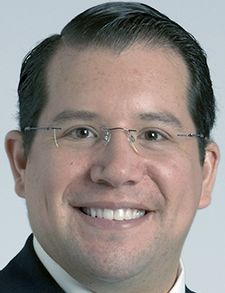
Dr. Auron
Hospitalists need to speak up on the job if they want to contribute to their hospital’s commitment to sustainability, which means a building that produces less waste, said Moises Auron, MD, FAAP, FACP, SFHM, a hospitalist and member of the Board of Governors at the Cleveland Clinic in Cleveland, Ohio. “Frontline hospitalists typically aren’t asked to be part of building-design teams, but we need to be meaningful stakeholders. If we don’t speak up, we won’t be heard. That means engaging with others in the system. I’d say, don’t be afraid to reach out to your leaders with your suggestions for space-use improvement and optimization,” he said.
“You could bring the designers in to sit down with the hospitalists and say, ‘We’re designing a new hospital. We want to brainstorm with you.’” The conversation should also include frontline nurses, he said. “Come to the night shift. Get people from all levels. Go on rounds with the hospitalists. Shadow them. Where do they park? Where are their offices located? Where will they clean their hands prior to entering a patient’s room?”
Dr. Auron said he does a lot of networking around issues like these. “I speak for myself. I have met with key stakeholders of the team that is designing a new hospital for our system. They are trying to enhance the new building’s sustainability and energy efficiency.”
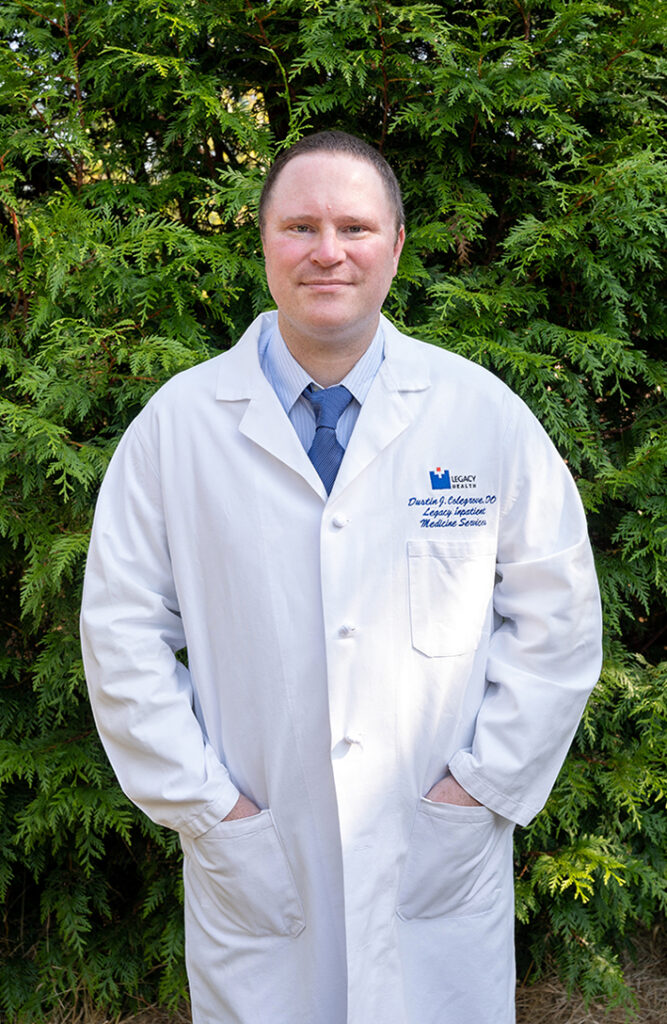
Hospitalists like Dr. Colegrove help their institutions embrace sustainability
The first step for hospitalists is to talk to their group leaders when they see sustainability issues they think need to be addressed, said Dustin Colegrove, DO, MBA, FACP, HMDC, a hospitalist at Legacy Salmon Creek Medical Center in Vancouver, Wash. “We lead the hospital in many ways—we’re the glue, the backbone. I’d like to think our voices are heard and our administration is responsive to our ideas in this area, as well.”
In recent years, the seven-hospital Legacy system has emphasized accessible green spaces and therapeutic hospital gardens developed with the leadership of horticultural therapists. It also studied the impact of its nature access on job stress and patient outcomes. All Legacy gardens are designed with environmental sustainability in mind, using organic and safe methods of garden maintenance. “The gardens matter more to some patients than others, but when we have sunny days, we know people go out there to enjoy them,” Dr. Colegrove said.
Making your voice heard
Ms. Wohlford said Carilion’s sustainability efforts naturally link back to its hospitalists. “We’re trying to figure out how to bring hospitalists and other physicians and staff into the spaces where leaner energy decisions are being made—helping them bring their clinical voice to those decisions. That way, it’s more than just a conversation about money and BTUs, it’s about helping facilities and maintenance folks really see and feel the links between the work they’re doing, patient health, community health, and the health of the environment,” she said.
“What are you ordering for your patients? Do your order sets bring excessive amounts of supplies into patients’ rooms, which then must be thrown away unused? Can these order sets be pared down?” Ms. Wohlford said. What else can hospitalists do? She suggested going to the units where they primarily work and connecting with the unit’s sustainability champion or director of nursing to better understand the sustainability opportunities in the units.
“As the sustainability professional at Carilion Clinic, what I could use most immediately is to have hospitalists reach out and connect with me. If this is something that resonates with them, and they have a desire to engage—or frankly, even just to be in the room—I need to know their names. I always have opportunities that bubble up, but if I don’t know your name, then I can’t include you,” she said.
“We can connect them with the leaders of the relevant departments and help to facilitate sustainability conversations. If the hospital leaders who need to implement change are not hearing that this is a priority to their physicians, then they may not go as far down this path,” Ms. Wohlford said. “But if you have physicians coming in and saying: ‘Hey, this is important to me,’ it helps to rally and build that groundswell.”
The next step in stewardship
Environmental stewardship by hospitalists can extend one step further: to the patients they care for who are confronting the effects of climate change more directly, for example from California’s extreme wildfires in recent years for asthmatic patients or from heat-related illnesses and complications for heart conditions and pregnancy triggered by this past summer’s extreme heat waves.
A recent report from the Medical Society Consortium on Climate and Health estimates that health costs, physical and mental, from air pollution and climate change already far exceed $800 billion per year.1 Climate change has also been associated with exacerbated risk for several types of cancer.2
“We need to be talking with our patients about this and identifying our most vulnerable patients to prevent the impact of climate change,” Dr. Gundling said. One of the projects her students at UCSF worked on was to survey clinicians asking if they are aware of any conversations currently happening with patients in the UCSF health system about the threat of climate change to their personal health. The answer, largely, was no, with no structured process for discussing the risks patients face.
“We’ve been talking about how to come up with tools to educate our faculty and physicians on the best ways to bring up these topics and to develop a curriculum for it,” Ms. Lee said. How will they avoid the wildfire smoke that exacerbated their asthma? Do they have windows that shut properly if they are likely to be exposed? What can they do to cool off on very hot days?
“If they don’t have good answers to these questions, do we then need to connect them with public health resources?” Dr. Gundling said. “We’re trying to build up more awareness as we learn more about the impact of climate change on health, and help professionals see their work through that lens.”
Resources
- Practice Greenhealth
- Sustainability Roadmap for Hospitals
- Health Care Without Harm
- U.S. Green Building Council
- Virginia Clinicians for Climate Action
- Medical Society Consortium on Climate and Health
Larry Beresford is an Oakland, Calif.-based freelance medical journalist, a specialist in hospice and palliative care, and a long-time contributor to The Hospitalist.
References
- Limaye, V. The costs of inaction: The economic burden of fossil fuels and climate change on health in the United States. Natural Resources Defense Council. https://www.nrdc.org/resources/costs-inaction-economic-burden-fossil-fuels-and-climate-change-health-us. Published May 20, 2021. Accessed August 28, 2022.
- Nogueira LM, et al. Climate change and cancer. CA Cancer J Clin. 2020;70(4):239-244. doi: 10.3322/caac.21610.
Sidebar: Commitment to the Environment
A key proponent of sustainability efforts at the Carilion Health System is Jessica Fleming, DO, currently chief resident of internal medicine at Carilion Roanoke Medical Center, where she functions as an academic hospitalist and educator. Her interest in environmental issues dates back to the volunteer work she has done in wildlife restoration and conservation.

Dr. Fleming
Dr. Fleming got a degree in clinical herbal medicine before starting medical training. “I applied for medical school because I enjoyed working with people and being a healer. And I have been doing sustainability and botany work ever since.” Away from the hospital, she is president of the Blue Ridge Wildflower Society, a regional non-profit organization that educates the public on native landscaping and restoration. She also volunteered at a wildlife rehabilitation center where people bring injured or orphaned wild animals to be rehabilitated and released.
These commitments have given her a greater appreciation for native flora and fauna and the benefits of using native plants in landscaping design—whether on hospital grounds or in residential backyards. Dr. Fleming also helped to spearhead a native-species planting day held at the hospital.
“Hospitals in this country can greatly impact ecosystem restoration by how they choose to landscape,” she said. “Hospital campuses comprise many acres of land, opening opportunities to restore habitat and healing gardens that attract native migratory birds and butterflies.” She also recommended green roofing as a way to save money on energy expenditures.
Dr. Fleming sits on the Carilion Clinic’s system-wide Sustainability Committee and is part of a current grant application to support teaching in the community. “I often lose sleep over nature conservation issues. I wish I didn’t care quite so much, but it’s wired into the framework of my being. I will always be working on nature conservation in some shape or form,” she said.
“For hospitalists, there is a wide spectrum of ways to get involved. People trust physicians, and most hospitalists have considerable training in biology. Hospitalists interested in nature conservation can volunteer to help plan new hospital structures and landscaping. Advocate for the benefits of spending more time in nature, both for your patients and for yourself,” she said.
Find groups like Virginia Clinicians for Climate Action or the Medical Society Consortium on Climate and Health. “Participate in recycling and refill events. Know where your hospital recycles, and if it doesn’t already, help to start it. See if it has a sustainability committee. If it doesn’t, start one.”